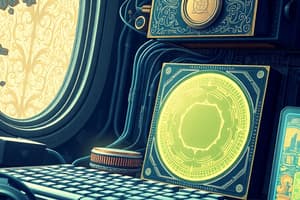Podcast
Questions and Answers
What is the primary function of the CPU in a computer system?
What is the primary function of the CPU in a computer system?
- To provide temporary storage for running programs
- To perform arithmetic and logical operations (correct)
- To control input and output devices
- To store data and files permanently
Which component is responsible for temporarily storing data and instructions needed by the CPU?
Which component is responsible for temporarily storing data and instructions needed by the CPU?
- CPU cache
- RAM (Random Access Memory) (correct)
- Solid-state drive (SSD)
- Hard drive
Which of the following is NOT an example of an input device?
Which of the following is NOT an example of an input device?
- Mouse
- Keyboard
- Monitor (correct)
- Touchscreen
What is the primary purpose of storage devices like hard drives and SSDs?
What is the primary purpose of storage devices like hard drives and SSDs?
Which of the following is an example of an output device?
Which of the following is an example of an output device?
What is the primary difference between RAM and storage devices like hard drives and SSDs?
What is the primary difference between RAM and storage devices like hard drives and SSDs?
Flashcards are hidden until you start studying
Study Notes
Hardware Components of Computers
Computer systems have several essential parts that work together to perform their intended functions. These components can generally be divided into hardware and software categories. This article focuses on the hardware components of computers.
Processor (CPU)
The CPU is considered the brain of a computer system. It performs arithmetic operations and logical steps necessary to execute programs and applications. Intel and AMD processors are commonly used in personal computers.
Memory
Memory refers specifically to RAM, which is volatile memory (it does not retain data when power is lost). It temporarily stores information needed by the processor to operate.
Storage
Storage devices like hard drives and SSDs store files and programs permanently. Additionally, external storage options like USB drives, SD cards, and cloud storage offer additional capacity and flexibility.
Input Devices
Input devices allow users to interact with computers through mechanisms such as typing on keyboards, clicking mouse buttons, or using touchscreens. Some input devices are specialized, like joysticks for gaming or microphones for voice commands.
Output Devices
Output devices display or reproduce the results produced by a computer's processing. Common output devices include monitors, printers, speakers, and headsets. They help to make the user experience more engaging and convenient.
Motherboard
The motherboard acts as the main circuit board where all the different types of peripherals connect. It provides communication between these components and ensures they function properly within a computer system.
Power Supply Unit
This component converts alternating current (AC) from the wall socket to direct current (DC), which powers the various electronic components inside a computer.
These are some of the primary hardware components found in most computer systems. Understanding their roles helps to appreciate the complexity involved in creating functional computing devices.
Studying That Suits You
Use AI to generate personalized quizzes and flashcards to suit your learning preferences.




